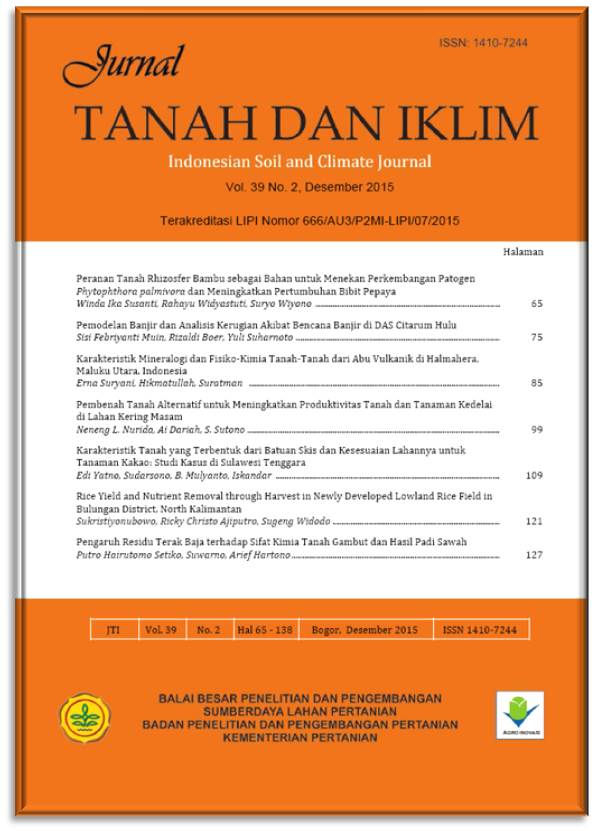Karakteristik Tanah yang Terbentuk dari Batuan Skis dan Kesesuaian Lahannya untuk Tanaman Kakao: Studi Kasus di Sulawesi Tenggara
Abstract
Abstrak. Karakteristik tanah yang terbentuk dari batuan skis dan kesesuaian lahannya untuk tanaman kakao di Kabupaten Kolaka dan Kolaka Timur belum banyak diketahui. Empat profil tanah yang terbentuk dari batuan skis telah dianalisis contoh tanahnya untuk mengetahui karakteristik tanah dan kesesuaian lahannya untuk kakao. Evaluasi kesesuaian lahan dilakukan dengan cara mencocokkan antara karakteristik lahan dengan persyaratan tumbuh tanaman. Hasil penelitian menunjukkan bahwa komposisi mineral fraksi pasir didominasi oleh kuarsa, sedangkan mineral liat tersusun dari kaolinit, ilit, vermikulit, dan interstratifikasi ilit-vermikulit. Tanah dicirikan oleh tekstur lempung sampai liat, bobot isi sedang hingga tinggi (0,95-1,41 g cm-3), air tersedia rendah hingga tinggi (7-19%), dan permeabilitas lambat sampai sedang (0,22-2,74 cm jam-1). Reaksi tanah masam (pH 4,60-5,41). Kandungan C organik rendah hingga sangat rendah (0,21-1,71%). Kandungan P tersedia sangat rendah (<6 mg kg-1), sedangkan kandungan P2O5 dan K2O potensial sedang sampai tinggi (20-84 mg 100g-1 dan 15-54 mg 100g-1). Kandungan Ca dapat tukar rendah (0,18-4,25 cmolc kg-1). KTK tanah dan kejenuhan basa rendah sampai sedang (7,33-20,69 cmolc kg-1 dan 13-60%), sedangkan kejenuhan Al sedang sampai sangat tinggi (11-82%). Pada tingkat famili, tanah di Samaturu dengan topografi berbukit (profil SK 1 dan SK 2) diklasifikasikan sebagai Typic Hapludults, halus, campuran, isohipertermik, sedangkan tanah di Ladongi dengan topografi bergelombang (profil SK 3 dan SK 4) diklasifikasikan sebagai Typic Paleudults, halus, campuran, isohipertermik. Tanah sesuai marginal (kelas S3) untuk tanaman kakao dengan pembatas reaksi tanah masam dan lereng curam (profil SK 1 dan SK 2), reaksi tanah masam dan C organik sangat rendah (profil SK 3 dan SK 4). Pemberian bahan organik dan kapur pertanian diperlukan untuk meningkatkan produktivitas tanah ini bagi pengembangan tanaman kakao.
ÂÂÂÂ
Abstract. Characteristics of soils developed from schist and their land suitability for cocoa in Kolaka and East Kolaka Regencies have not been known. Four soil profiles developed from schist were sampled and analyzed to determine their soil characteristics and land suitability for cocoa. Land suitability evaluation was conducted by matching method between land characteristics and crop requirements. Results indicated that sand mineral composition was dominated by quartz, while clay minerals were composed of kaolinite, illite, vermiculite, and illite-vermiculite interstratification. The soils were characterized by loam to clay textures, medium to high bulk density (0.95 to 1.41 g cm-3), low to high available water (7-19%), and slow to moderate (0.22-2.74 cm hour-1) permeability. The soil reaction was acid (pH 4.60-5.41). The soil organic carbon content was low to very low (0.21-1.71%). The available P content was very low (<6 mg kg-1), while potential P2O5 and K2O contents were medium to high (20-84 mg 100g-1 and 15-54 mg 100g-1, respectively). The exchangeable Ca content was low (0.18-4.25 cmolc kg-1). The soil CEC and base saturation were low to medium (7.33-20.69 cmolc kg-1 and 13-60%, respectively), while Al saturation was medium to very high (11-82%). At a family level, soils in Samaturu with hilly topography (profiles SK 1 and SK 2) were classified as fine, mixed, isohyperthermic, Typic Hapludults, while soils in Ladongi with rolling topography (profiles SK 3 and SK 4) were classified as fine, mixed, isohyperthermic, Typic Paleudults. All soils were marginally suitable (class S3) for cocoa crop with limiting factors of acid soil reaction and steep slope (profiles SK 1 and SK 2), acid soil reaction and very low organic C (profiles SK 3 and SK 4). Addition of organic matters and agricultural lime is required to increase the soil productivity for cocoa development.


